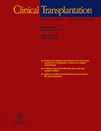Prospective study of polyomavirus BK replication and nephropathy in renal transplant recipients in China: a single-center analysis of incidence, reduction in immunosuppression and clinical course
Abstract
Huang G, Chen L-Z, Qiu J, Wang C-X, Fei J-G, Deng S-X, Li J, Chen G-D, Zhang L, Fu Q, Zeng W-T, Zhao D-Q. Prospective study of polyomavirus BK replication and nephropathy in renal transplant recipients in China: a single-center analysis of incidence, reduction in immunosuppression and clinical course.Clin Transplant 2009 DOI: 10.1111/j.1399-0012.2009.01141.x© 2009 John Wiley & Sons A/S.
Abstract: Background: BK virus (BKV)-associated nephropathy (BKVAN) in renal transplant recipients is an important cause of renal transplant dysfunction. Our aim was to determine the kinetics of BKV load within one yr after kidney transplantation under the impact of intensive monitoring and reduction in maintenance immunosuppression, the incidence of BKVAN, and the outcome of BKVAN treatment.
Methods: Urine and peripheral blood (PB) were taken from 90 renal transplant recipients for BKV cytological testing and real-time PCR for BKV DNA at one, three, six, nine, and 12 months after transplantation and treatment. Graft biopsies and urinary sediments of recipients with BKVAN were taken to monitor viral particles by conventional transmission electron microscopy (TEM).
Results: By one post-transplant year, urinary decoy cells (median, 8/10 HPF), BKV viruria (median, 2.60 × 105 copies/mL), viremia (median, 9.65 × 103 copies/mL), and BKVAN occurred in 42.2%, 45.6%, 22.2%, and 5.6% of patients, respectively. The incidence of BK infection was lower in patients who received cyclosporine A (CsA) (28.9%) compared to tacrolimus (FK506) (57.7%) (p = 0.007). An increased hazard of BK infection was associated with the use of FK506 (HR 2.6, p = 0.009) relative to CsA. After reduction in immunosuppression, viremia resolved in 95%, without increased acute rejection, allograft dysfunction, or graft loss. BKVAN was diagnosed in five patients (5.6%). The treatment of immunosuppression reduction was effective (i.e., decreased the viral load and number of decoy cells, and improved graft function) in our five patients with BKVAN. Quantitative count of decoy cells (e.g., >10 per 10 HPF) as a marker of viremia and BKVAN had increased positive predictive values of 85.7% and 57.1%, respectively.
Conclusions: Choice of FK506 as immunosuppressive agent is an independent risk factor affecting BKV infection. Monitoring and pre-emptive of immunosuppression reduction were associated with resolution of viremia and showed effective in BKVAN recipients at the early stage without acute rejection or graft loss. Quantitative count of urine cytology is a very convenient, useful, and sensitive method for evaluating BKV infection in renal transplant recipients.




